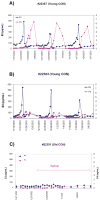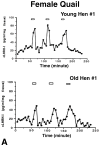Mechanisms of reproductive aging: conserved mechanisms and environmental factors
- PMID: 20738277
- PMCID: PMC2929979
- DOI: 10.1111/j.1749-6632.2010.05653.x
Mechanisms of reproductive aging: conserved mechanisms and environmental factors
Abstract
The interplay of neuroendocrine processes and gonadal function is exquisitely expressed during aging. In females, loss of ovarian function results in decreased circulating estradiol. As a result, estrogen-dependent endocrine and behavioral responses decline, including impaired cognitive function reflecting the impact of declining estrogen on the hippocampus circuits, and decreased metabolic endocrine function. Concurrently, age-related changes in neuroendocrine response also contribute to the declining reproductive function. Our session considered key mechanisms in reproductive aging including the roles of ovarian function (Finch and Holmes) and the hypothalamic median eminence (Yin and Gore) with an associated age-related cognitive decline that accompanies estrogen loss (Morrison and colleagues). Effects of smoking, obesity, and insulin resistance (Sowers and colleagues) impact the timing of the perimenopause transition in women. Animal models provide excellent insights into conserved mechanisms and key overarching events that bring about endocrine and behavioral aging. Environmental factors are key triggers in timing endocrine aging with implications for eventual disease. Session presentations will be considered in the context of the broader topic of indices and predictors of aging-related change.
Figures





Similar articles
-
Neuroendocrine aging precedes perimenopause and is regulated by DNA methylation.Neurobiol Aging. 2019 Feb;74:213-224. doi: 10.1016/j.neurobiolaging.2018.09.029. Epub 2018 Oct 5. Neurobiol Aging. 2019. PMID: 30497015 Free PMC article.
-
Neuroendocrine involvement in aging: evidence from studies of reproductive aging and caloric restriction.Neurobiol Aging. 1995 Sep-Oct;16(5):837-43; discussion 855-6. doi: 10.1016/0197-4580(95)00072-m. Neurobiol Aging. 1995. PMID: 8532119 Review.
-
Neuroendocrine physiology of the early and late menopause.Endocrinol Metab Clin North Am. 2004 Dec;33(4):637-59. doi: 10.1016/j.ecl.2004.08.002. Endocrinol Metab Clin North Am. 2004. PMID: 15501638 Review.
-
Development of a Chemical Reproductive Aging Model in Female Rats.Bio Protoc. 2021 Apr 20;11(8):e3994. doi: 10.21769/BioProtoc.3994. eCollection 2021 Apr 20. Bio Protoc. 2021. PMID: 34124295 Free PMC article.
-
Neuroendocrine concomitants of reproductive aging.Exp Gerontol. 1994 May-Aug;29(3-4):275-83. doi: 10.1016/0531-5565(94)90007-8. Exp Gerontol. 1994. PMID: 7925748 Review.
Cited by
-
Exploring the Ovarian Reserve Within Health Parameters: A Latent Class Analysis.West J Nurs Res. 2018 Dec;40(12):1903-1918. doi: 10.1177/0193945918792303. Epub 2018 Aug 9. West J Nurs Res. 2018. PMID: 30089444 Free PMC article.
-
Toward Sustainable Environmental Quality: Priority Research Questions for North America.Environ Toxicol Chem. 2019 Aug;38(8):1606-1624. doi: 10.1002/etc.4502. Environ Toxicol Chem. 2019. PMID: 31361364 Free PMC article. Review.
-
Association of adiposity, telomere length and mortality: data from the NHANES 1999-2002.Int J Obes (Lond). 2018 Feb;42(2):198-204. doi: 10.1038/ijo.2017.202. Epub 2017 Aug 16. Int J Obes (Lond). 2018. PMID: 28816228 Free PMC article.
-
Understanding Reproductive Aging in Wildlife to Improve Animal Conservation and Human Reproductive Health.Front Cell Dev Biol. 2021 May 19;9:680471. doi: 10.3389/fcell.2021.680471. eCollection 2021. Front Cell Dev Biol. 2021. PMID: 34095152 Free PMC article. Review.
-
The stromal microenvironment and ovarian aging: mechanisms and therapeutic opportunities.J Ovarian Res. 2023 Dec 13;16(1):237. doi: 10.1186/s13048-023-01300-4. J Ovarian Res. 2023. PMID: 38093329 Free PMC article. Review.
References
-
- Klein NA, Houmard BS, Hansen KR, Woodruff TK, Sluss PM, Bremner WJ, Soules MR. Age-related analysis of inhibin A, inhibin B, and activin a relative to the intercycle monotropic follicle-stimulating hormone rise in normal ovulatory women. J Clin Endocrinol Metab. 2004;89(6):2977–81. - PubMed
-
- van Rooij IA, Broekmans FJ, te Velde ER, Fauser BC, Bancsi LF, de Jong FH, Themmen AP. Serum anti-Mullerian hormone levels: a novel measure of ovarian reserve. Hum Reprod. 2002;17(12):3065–71. - PubMed
-
- Wu JM, Zelinski-Wooten M, Ingram DK, Ottinger MA. Ovarian aging and menopause: Current theories and models. Exper Biol Med. 2005;230:818–828. - PubMed
-
- Tremellen KP, Kolo M, Gilmore A, Lekamge DN. Anti-mullerian hormone as a marker of ovarian reserve. Aust N Z J Obstet Gynaecol. 2005;45(1):20–4. - PubMed
Publication types
MeSH terms
Grants and funding
LinkOut - more resources
Full Text Sources
Medical
Research Materials

